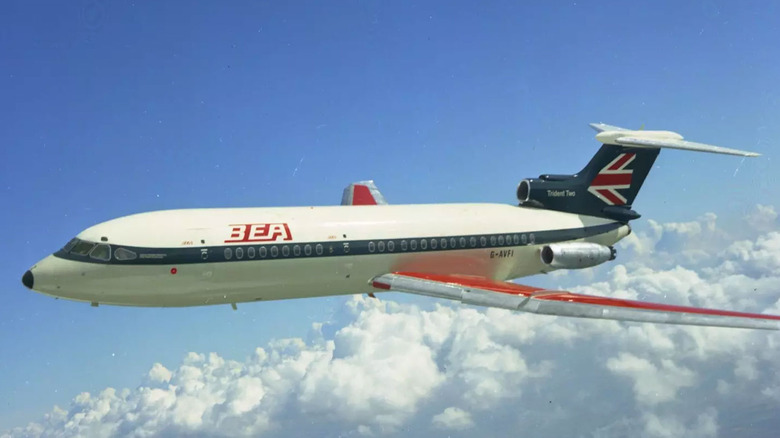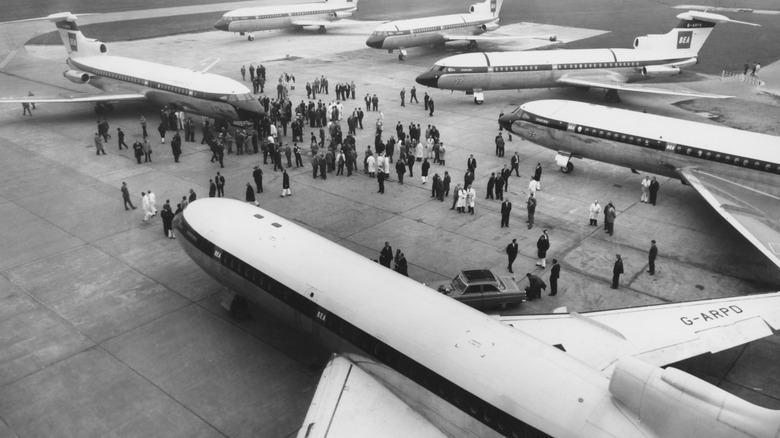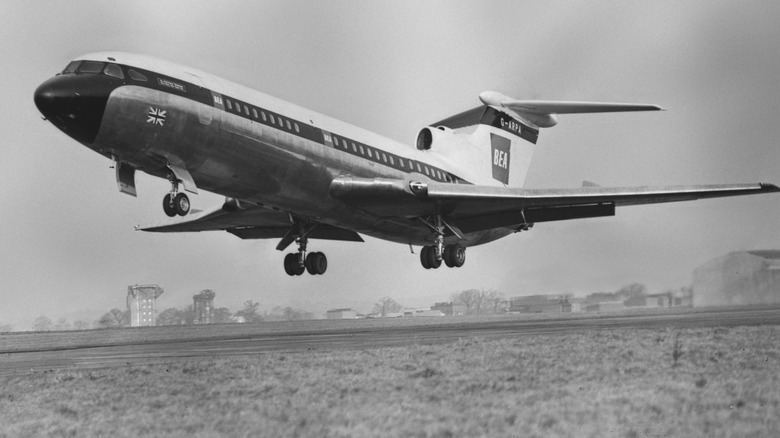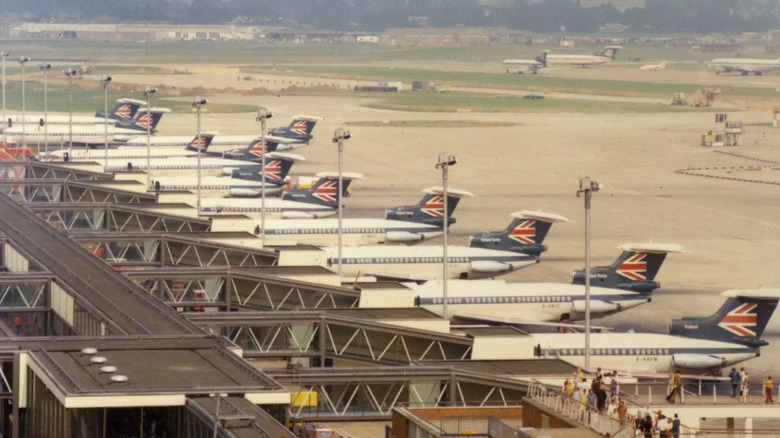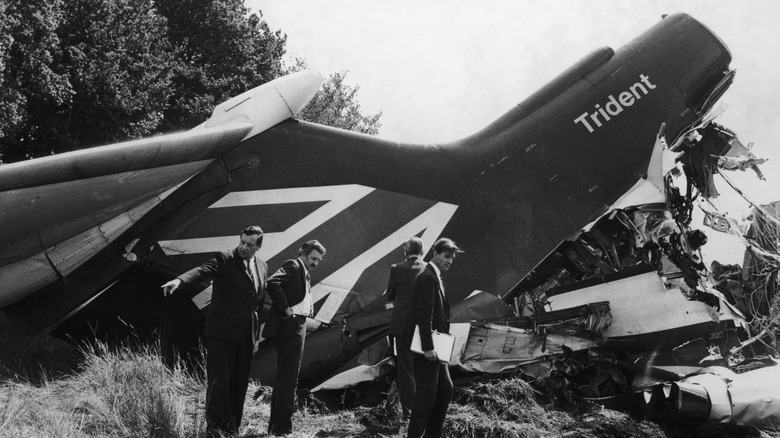What Made The Hawker Siddeley Trident Unique To Jet Aviation
Whether it's the amazing vertical takeoff abilities of the Harrier Jet or widely-used commercial jets like the Boeing 737, air flight has seen a multitude of important innovations since jet engine technology was developed. While many of these iconic airplanes are certainly memorable due to wide adoption after development, other pioneering airplanes often get overshadowed.
The Hawker Siddeley Trident is one such aeronautic marvel featuring a few firsts in terms of flight. Although the Soviet Tupolev Tu-73 was officially the first tri-engine jet to take flight in 1947, that plane never entered full production, with major problems plaguing its development. The Trident is the first successfully manufactured plane featuring a three-engine design and T-tail designed specifically for commercial flight.
Ultimately, development delays, unreasonable expectations, and a few catastrophic missteps caused the Trident to be less produced and thus less recognized than other iconic tri-engine planes like Boeing's 727, though it still stands as a pioneer in the earliest development of commercial jet planes.
The Trident was the first commercial trijet ever
Originally conceived by the de Havilland Aircraft Company under the designation DH121 Trident 1C, development for the Trident jet officially started in 1957 when de Havilland submitted a proposal to British European Airways (BEA). The goal? To develop a long-haul commercial jet with enough power and range to act as the organization's main passenger airplane. Prior to this, the UK was somewhat hesitant to adopt turbojet engine technology, leading to the popularity of the turboprop engines of the Vickers Viscount and later the Vanguard.
Three engines were proposed to fulfill the BEA's somewhat arbitrary requirement for the plane to have more than two engines, as the organization believed the requirement would provide options with the capabilities to fulfill its range and passenger needs. By 1958, de Havilland finalized the agreement with the BEA and began production on 24 DH121s. In 1960, de Havilland merged with Hawker Siddeley, changing the plane's designation to the Hawker Siddeley HS121 Trident.
The Hawker Siddeley Trident had a few interesting innovations
The first flight of the Hawker Siddeley Trident prototype occurred on January 9, 1962, in Hatfield, England. By this time, the plane had been modified and changed to adhere to BEA's specifications. The original Trident 1A was equipped with Rolls-Royce Medway engines for increased fuel capacity, but by 1962, the company was already developing the Trident 1C that utilized Rolls-Royce Spey engines.
The Trident was the world's first three-jet airliner, with two turbojet engines mounted on the rear fuselage and a third engine mounted inside the rear fuselage. Its low-swept wing design and T-tail gave the commercial jet a unique, sleek look. In addition to the design differences and unique configuration, the Trident also set the standard in some other ways.
Notably, the plane had an advanced avionics system that made it the first airliner capable of a fully automatic blind landing. This would enable pilots to navigate the often foggy runways of Europe, with the first fully blind landing of the jet occurring in November of 1966.
Using an inventive idea, engineers at Hawker Siddeley developed a Doppler system to report the plane's position, which was displayed on a rolling piece of paper (rather than screen). The Trident also had a reverse thrust system that could be used in the air to slow down the plane as it descended for landing, making it unique among its peers.
A series of missteps doomed the Trident
Originally, de Havilland Aircraft Company hoped to provide the Trident to American Airways to break into the aircraft market in the United States. To do this, the company created a consortium early during development and teamed up with Hunting Aircraft and Fairey Aviation Company to create the new plane.
Operating under the belief that Boeing would eventually want to produce the Trident under license, the company invited them to their headquarters to view development. Unfortunately for the engineers working on the Trident, Boeing decided to develop its own commercial trijet, the iconic Boeing 727, just one year later, in 1959. Ultimately, it would be Boeing's plane that would win the American Airlines contract and go down as arguably the most recognizable and most-used trijets for commercial flight.
In addition, though the plane's thin-wing design enabled it to move at the relatively swift speed of 937 kilometers per hour, lift at low speeds was hard to achieve. This would grant the Trident the nickname "The Gripper," as it took the plane a longer-than-usual amount of time and runway space to actually lift off the ground.
The Trident never lived up to its potential
Competition from Boeing wasn't the only reason the Trident's innovative design would be relegated to a lesser-known entry in aviation history. Constant design changes to adhere to the ever-moving BEA requirements forced the company to develop the plane for a specific airline rather than developing a plane that would appeal to a variety of companies. This would further contribute significantly to the aircraft's lack of success compared to the 727, leading to five different variations of the plane being created over its lifetime.
One of the main modifications came in the form of the maximum passenger capacity for the jet. Commercial flights were much lower in demand at the time, prompting the BEA to set a requirement for the planes to accommodate less than 100 passengers. While Hawker Siddeley had the foresight to increase the payload, later models like the Trident 2E and 3B were designed for 150 and 180 passengers, respectively, with the plane continuing to undergo constant development during its time in use.
In addition to building the jets for the BEA, Hawker Siddeley also constructed the Trident for the Civil Aviation Administration of China (CAAC), but it was eventually retired in 1986 to adhere to more stringent noise regulations in the country. Though highly popular in China, the Boeing 727 saw much greater use worldwide. In total, only 117 Tridents were constructed, compared to the Boeing 727, in which 1,832 units were eventually produced.
